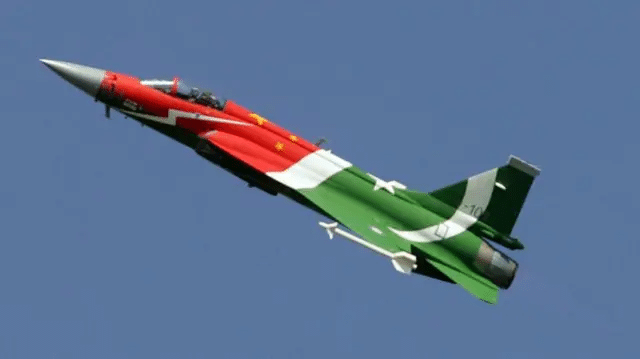From Jets to Drones
 From Jets to Drones
From Jets to DronesDuring recent flare-ups in tensions between Pakistan and India, military developments and defence industry dynamics have once again come into focus. Notably, the share prices of Chinese defence companies surged, particularly those that manufacture weapons and fighter jets for Pakistan. Among the biggest beneficiaries was the Hong Kong-listed Avec Chengdu Aircraft Corporation, which produces the J-10C fighter jet, one of Pakistan’s frontline aircraft. The spike in its share value, reportedly rising by 6 percent in Hong Kong and 16 percent in Shenzhen on May 8, underscores the growing strategic defence ties between Beijing and Islamabad.
Pakistan’s deepening reliance on Chinese weaponry is not a new development, but it is gaining momentum in both scale and sophistication. The two countries have maintained a close military partnership for decades, with China emerging as Pakistan’s largest arms supplier. From fighter jets to naval assets, missile systems, and increasingly, unmanned aerial vehicles (UAVs), Pakistan’s military inventory is now heavily infused with Chinese-made platforms.
The most visible symbol of this relationship is the JF-17 Thunder, a lightweight, multirole combat aircraft co-developed by Pakistan and China. While this project highlights a level of local manufacturing and technical input from Pakistan’s side, most of its core components, including avionics and engines, are Chinese. In recent years, however, Pakistan has gone a step further, importing the more advanced J-10C jets. These fourth-generation fighters are equipped with modern radar systems and can carry sophisticated air-to-air and air-to-ground munitions, many of which are also Chinese in origin.
The claim by Pakistani Foreign Minister Ishaq Dar in May 2025 that Chinese J-10Cs were responsible for downing Indian Rafale aircraft during heightened border tensions, though yet to be confirmed by independent or Indian sources, demonstrates how deeply Pakistan has embedded Chinese systems into its frontline capabilities. Whether this specific engagement occurred as claimed or not, it reflects Pakistan’s confidence in Chinese hardware and its willingness to publicly attribute operational success to Chinese platforms.
This partnership extends beyond the air force. China has supplied Pakistan with a variety of missile systems, including the HQ-9 surface-to-air missile system, the LY-80 medium-range air defence system, and a range of cruise missiles. On the naval front, Pakistan has procured Chinese-made submarines and warships, including the Type 054A frigates and Hangor-class submarines, which are expected to significantly bolster Pakistan’s maritime posture.
In the realm of drones, the collaboration has also intensified. Pakistan has been acquiring and deploying Chinese-made UAVs like the Wing Loong II, which provides surveillance and strike capabilities. This technology is particularly relevant in counterinsurgency and surveillance operations along the western borders and in disputed territories. The availability of cost-effective, combat-tested Chinese drones has given Pakistan a technological edge without the fiscal burdens of Western UAV programs.
Looking ahead, this reliance on Chinese weapon systems is poised to increase, not just because of geopolitical alignment but also due to practical and economic factors. Western arms suppliers are often constrained by political considerations, end-use monitoring requirements, and higher costs. By contrast, China offers more flexible financing, technology transfer agreements, and fewer political strings. For a country like Pakistan, facing recurring economic challenges and security threats, this model is both appealing and essential.
Furthermore, China’s Belt and Road Initiative, of which the China-Pakistan Economic Corridor (CPEC) is a flagship component, adds another layer of strategic depth to the relationship. As economic and infrastructural ties deepen, defence cooperation becomes a natural extension of mutual interests. Joint exercises, co-development programs, and interoperability of defence systems further cement this alignment.
However, there are potential risks in this growing dependency. One concern is the lack of diversification in Pakistan’s defence procurement. Relying heavily on a single supplier, particularly one that may itself be subject to international scrutiny or sanctions, can create vulnerabilities. Additionally, despite improvements, Chinese systems have historically lagged Western technology in certain domains such as electronic warfare and stealth capabilities.
There is also the strategic calculus to consider. Greater military dependence on China may limit Pakistan’s manoeuvrability in foreign policy, potentially forcing alignment with Chinese positions even when they do not serve Islamabad’s interests. This could reduce Pakistan’s ability to act as a bridge between competing global powers, a role it has attempted to play in the past.
Nevertheless, for now, the trajectory of Pakistan-China defence cooperation is upward. Whether through high-profile jet purchases like the J-10C, advanced missile systems, or the next generation of combat drones, Pakistan is doubling down on its defence partnership with China. Given current geopolitical trends and internal defence requirements, this reliance is likely to deepen in the coming years, shaping not just Pakistan’s military landscape but also the broader strategic balance in South Asia.











